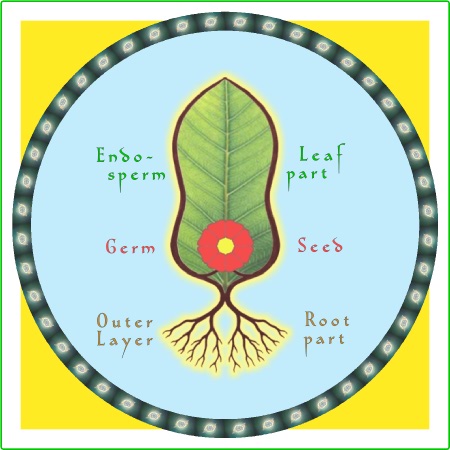

Archetype of a Grain
The grains are the most balanced food in regard to the
principle of the threefold plant because each their kernel contains the
characteristics of all three parts of a plant. For that reason cereals are not
one-sided seeds, or one-sided roots, or one-sided leaves, but they contain all
three parts in a harmonious proportion – the root in the outer coat, the leaf in
the starchy endosperm and the seed in the germ of the grain kernel.

Introductory Reading:
♦ PRINCIPLE OF THREEFOLD PLANT
Although grains are seeds we do not count them in the
Flower–Fruit–Seed group when we compose a meal
according to the threefold principle. If we compare the composition of the
grain kernel with that of a plant, we can see the threefold structure in
both of them. As each part of the plant has different inner structure and
composition of substances so it is the case with grain kernels. If we
compare a grain kernel with a plant we can find the following relations:
- The
outer layer (also called seed coat) is the
Root part because it is the most
fibrous and mineralized part of the grain as is the case with the root
in relation to the whole plant.
[1] In both cases we find cellulose as its main
substance. The outer layer is the main source of dietary
fibre and minerals in the grain (called
bran in
nutrition).
- The endosperm is the
Leaf part of the grain, as it consists
mainly of starch which is created in the
leaves through the process of
photosynthesis. For example, the wheat endosperm is composed of 87%
starch and only 8% protein (the rest is fibre).
[2]
- The germ is the
Seed inside the grain kernel, because it is out of this part that the new plant starts to sprout and
grow. Although it is the smallest part of the grain kernel it has the
highest percentage of proteins and it is
the main source of fats. These substances came
into existence in the seeds of plants and therefore are dominant in them.
A pure grain dish – such as bread, porridge, muesli, or cooked rice
(just with some dairy products and condiments) – is therefore already a
balanced meal in regard to the principle of the threefold plant. Of course,
this is true only if we use whole grains!
This archetype is not valid for buckwheat, amaranth, quinoa and similar
seeds which don't belong to the grass family as the cereals do. These seeds
are listed in the group Flower-Fruit-Seed when
we compose a meal in accordance with the principle of the threefold plant.


